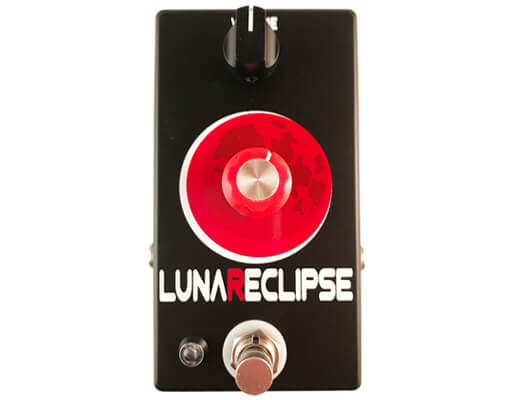Stacking gain pedals together is nothing new, but balancing it all out can be tough. Fuzzrocious has found a way with their LunaReclipse pedal, which brings the best out of whatever dirt box a player is already using.
There are two controls, a volume control and a 12-way rotary switch. There are 12 variations of Germanium, LED’s and Semi-conductor diodes that are selectable, and offer up various clipping options. Want to go a bit vintage? Germanium does the trick nicely. Want to go a bit more modern? The LED versions are quite nice.
Scrolling through the range, it doesn’t go from smaller to bigger, like a volume control does; each notch does its own thing, and if you’re playing with one setting and it’s really close to what you want, clicking to the next, it surprisingly changes radically, in both overall volume and tonal feel. That’s just the nature of what this does. It’s certainly a great pedal to really hunt down certain sounds.
Placing it after a distortion/overdrive pedal yields interesting results, as it’s re-clipping the signal (re-clips, get it?) and can act as a way to smooth out rougher, un-musical edges of the pedal. For players who like their distortion and drive pedals, but constantly think about getting mods done to them, this is an easier solution and offers up a lot more flexibility. We found using an EHX Soul Food that the 4:00 position was really nice, and a Mad Professor Tweedy Drive really opened things up at 4:00 and 8:00. While a more traditional Boss BD-2 Blues Driver really took at jump at 9:00. It’ll take some tweaking to figure out which settings work best with whatever pedal(s) it’s paired with. The signal seems to get clipped and compressed in a way to filter out unwanted frequencies that a pedal’s EQ and drive controls can’t control on their own. More of everything becomes available, — more sweetness on the leads, more depth and chunk on rhythms, and all while not adding in any additional noise or hiss to the existing signal. Bonus.
Humbuckers and single coils responded nicely, and plugging it into a variety of both solid-state and tube amps, it sounded fantastic! The only downside is that scrolling through all the variations can sometimes cause ear fatigue; it’s easy to spend a lot of time tweaking. After coming back to it with fresh ears, a player might ask, “What was I thinking?”
It’s not one of those pedals where switching settings between songs is probably going to be an option, as the volume and frequency response differences might require a lot of adjustment that might not be optimal in a live setting. A studio, however, should certainly look into having one of these. Yes, most studios defer to the guitar rigs their clients bring in, but this is an excellent addition to the arsenal, and can tame some of those hard-to-sit frequencies before trying to wade through a mix.
PROS:
Plenty of tonal options, regardless of the rig.
CONS:
Overzealous tweakers might go down the rabbit hole using it on its own.
PRICE:
$155
Rotary switch options:
- 1:00 – 1n914/1n914
- 2:00 – germanium / germanium
- 3:00 – 1n4001/1n4001
- 4:00 – LED/LED
- 5:00 – 1n914-1n914/1n914
- 6:00 – germanium – germanium / germanium
- 7:00 – 1n4001-1n4001/1n4001
- 8:00 – LED – LED /LED
- 9:00 – 1n914-1n914/germanium
- 10:00 – germanium – germanium /LED
- 11:00 – 1n4001-1n4001/LED
- 12:00 – clean boost
